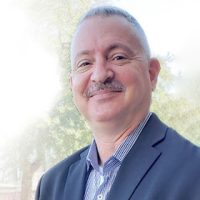Expert Panel:

Dr. William Wierda, President & CEO, CLL Global Research Foundation

Jeff Folloder, Moderator and CLL patient advocate
Our recent CLL Global Research Foundation Town Hall featured CLL Global President, Dr. William Wierda, and Dr. Constantine Tam from Monash University in Melbourne. CLL patient advocate Jeff Folloder moderated the event. Watch the full webinar.
Transcript
Jeff Folloder:
Just a little over a month ago, blood cancer experts from around the world met in San Diego for the annual American Society of Hematology meeting, or what we call ASH. And at this meeting, researchers reviewed CLL research, treatment, and technology advances. Dr. Wierda, are there highlights from the meeting that you would like to share with our viewers?
Dr. William Wierda:
I would love to. This is one of my sort of favorite things to do, and that’s just to highlight and touch on some of the important abstracts or presentations that were made at our meetings. Typically, our foundation town hall that we’re having right now, this time of year, is the opportunity to summarize the ash results, because the meeting is in December.
And then the other meeting that we have later on in the year is the opportunity to review data that’s presented at the European Hematology Association. And the American Society of Clinical Oncology meeting, as well as some others. And I have a list of the ones that we’re looking forward to the later on this year as the last slide. But this slide summarizes the presentations that were made that I think were important and relevant for our patients with CLL.
The ones in black are for previously untreated patients, and the ones in blue are for previously treated patients. So, I’m going to walk through each of these and just briefly give you a flavor of what was presented and discussed at ASH, and some of the very important and noted presentations and findings.
So, the first one there is a trial that we’ve been anticipating. It’s what’s called a Phase III randomized trial, where patients who need treatment are assigned to one of three different treatments on this trial. Acalabrutinib (Calquence) plus venetoclax (Venclexta) or acalabrutinib plus venetoclax plus obinutuzumab (Gazyva). Or a chemotherapy-based treatment, either FCR or bendamustine-rituximab (Treanda-Rituxan).
And the goal of this trial was to identify outcomes for patients with each of those treatments. Now, those are time limited therapies or fixed duration treatment. The acalabrutinib-based treatment was a year of treatment, and the chemotherapy was the standard six cycles or six months of treatment.
That trial was a positive trial, showing improved what’s called progression-free survival. You can think of it also as the duration of response or showing that that was improved for patients who received either acalabrutinib-venetoclax or acalabrutinib-venetoclax plus obinutuzumab over chemotherapy. And so, here we have another clinical trial done with targeted therapy in a randomized fashion demonstrating improved outcomes for the targeted therapy over chemotherapy. And the treatment was well-tolerated.
Now, one of the things that we saw with Ash this year was some of the complications of the pandemic. And those were patients who had developed COVID, and some of whom had died on these trials as a result of the COVID while they were on treatment. So, there was a fair number of patients on the trial that did have COVID and/or succumbed to the COVID infection. It was generally higher for patients who received the CD20 monoclonal antibody.
And we know that’s a risk. We knew that at the time. Many of us were avoiding obinutuzumab or rituximab during the pandemic in patients who hadn’t been vaccinated. Because we knew that there was an increased risk for severe infections and problem. But this trial was a positive trial. We’re anticipating its inclusion in the NCCN guidelines. We’re anticipating its approval by the FDA. It being AV or AVO.
The next trial was a trial that we’ve been doing at MD Anderson. Also targeted therapy. This is a Phase II trial, so all patients received the same treatment on this trial. They were all previously untreated. And they received a combination of pirtobrutinib (Jaypirca), Venclexta, and obinutuzumab. And with that combination – which is a year of treatment, six cycles or six months of obinutuzumab, and a year of pirto and venetoclax – we’re seen extremely high remission rates and very high rates of undetectable MRD with that combination.
Now, that’s not a comparative trial. We do tend to make cross-trial comparisons. But it gives us an idea about the potency and the activity of that combination. I would anticipate at some point it will be studied in a Phase III trial.
The next trial, which is the third one on the list, is a trial that was presented by Jake Sumarai, which is a combination of zanubrutinib (Brukinsa) plus sonrotoclax (BGB-11417). Now, sonrotoclax is a new BCL-2 inhibitor. It’s not yet approved by the FDA. It’s being developed by Beijing. And this combination has been studied in previously treated patients and also previously untreated patients. And this was an untreated cohort who received zanu plus sonrotoclax, and demonstrated significant activity, and that this was a well-tolerated combination.
And there’s a large, randomized trial that’s looking at this combination that’s ongoing and enrolling. Actually, I think it’s just recently completed enrollment. So, we’ll hear about data from that randomized trial.
And then the last of the untreated trials was a trial that we presented. It was in Anderson. A trial of venetoclax plus obinutuzumab plus atezolizumab (Tecentriq). This was a Phase II trial. Atezolizumab is a checkpoint inhibitor. And we were looking to see if we can improve outcomes with the addition of the checkpoint inhibitor. We saw very high undetectable MRD rate. And these patients are doing very well, and we’re continuing follow up on that trial.
Among the trials and data that was presented for previously treated patients, there’s a lot of activity and a lot of interesting things going on in this space. The first was a Phase III randomized trial of pirtobrutinib, which is a noncovalent reversible BTK inhibitor versus idelalisib (Zydelig) plus rituximab or bendamustine plus rituximab. That was a positive trial that showed improved outcomes for previously treated patients who received pirtobrutinib as their next therapy over idelalisib or rituximab.
Now, all of these patients enrolled on the trial had to have had a prior covalent BTK inhibitor. And so, this was a trial looking at patients who had been previously treated with a BTK inhibitor, a covalent BTK inhibitor. The activity and efficacy of those treatments among those patients.
The next study was an update that I presented, which was the liso-cel plus ibrutinib (Imbruvica). We’ve many times presented in the past liso-cel as a single agent. Now this is the CD19 CAR T-cell therapy. And this trial looked at liso-cel combined with ibrutinib. And we reported higher complete remission rate with that combination compared to liso-cel by itself on the TRANSCEND CLL 004 trial.
The next two abstracts that you see there are new drugs that are in development Phase I clinical trials. These are a category of drugs called degraders. There are more than just those two. These molecules are small molecules that are taken orally, and they induce degradation of BTK in the leukemia cells. And in doing that, they cause the CLL cells to die.
And so, these were two abstracts, early clinical trials looking at tolerability, and toxicity, and activity of these two agents, NX-5948 and the Beijing BGB-16673 compound. And we’re very excited in seeing activity with those compounds.
And then finally, epcoritamab (Epkinly). We’ve heard about epcoritamab on the trial that was presented. This was an update. And they made some changes in terms of the premedication and to improve the tolerability of epcoritamab for CLL. It’s also being studied in Richter transformation. And we’ve seen the abstract for Richter transformation presented recently also.
So, a lot of activity in previously treated patients. A lot of very exciting work and exciting agents that are – we look forward to moving forward in treatment and getting approval for our patients with CLL.
Jeff Folloder:
Sounds very exciting. I’m very excited to hear that its duration is one of the premier issues. I know that when we move from traditional chemo to the next wave of treatment, people were worried about being on meds for the rest of their life. And it just does my heart well to know that we’re looking at fixed duration.
Dr. Wierda, I know that every time I see you in clinic, I ask the same question over again. “If I had to start treatment today, what would it be?” And it seems like over the years, every time I ask that question, I get a different answer because things are moving so fast. What are you working on?
Dr. William Wierda:
So, my answer usually is a clinical trial. Now, I realize that not everybody has clinical trial options available to them. So, we dedicate a lot of time, and we have a lot of interest in developing our regimens and our clinical trial work in new combinations.
I mentioned the PVO trial, which is pirtobrutinib, a triplet that we’re seeing very good activity with. There is some increased risk for infection and suppression of the normal marrow. But right now, that it looks to be like our most active and effective combination. Which has been well-tolerated across our patient population. We’ve recently expanded it to 120 patient trial. And currently working and thinking about, “Okay, what’s the next thing that we’re going to do? What do we want to study for previously untreated patients?”
And it’s becoming more and more challenging, because we’ve done a great job in making progress. And it’s the goal. The thought and the challenge is moving the undetectable MRD rate up above what it is now. And if you’re starting at 90 percent, it’s hard to improve on that. There is room for improvement, but – so, we struggle. And I work to think about, “What’s the next advance? And how can we improve our outcomes for our patients with CLL?”
And I think because of the high MRD undetectable rates we’re seeing, that we really have to pivot and think about cure. And that has to be the focus right now for our newer trials. Particularly for patients with high-risk features.

